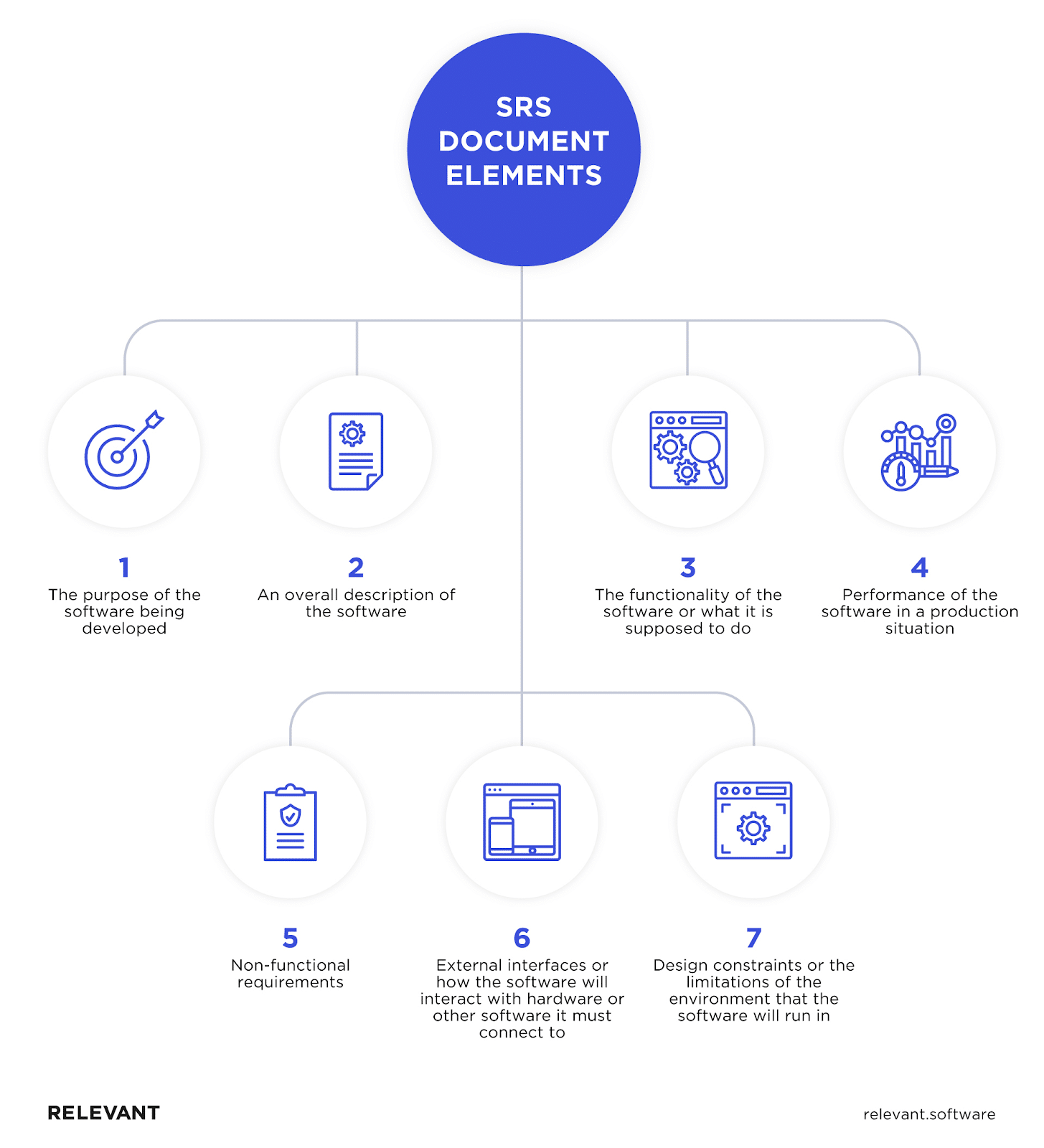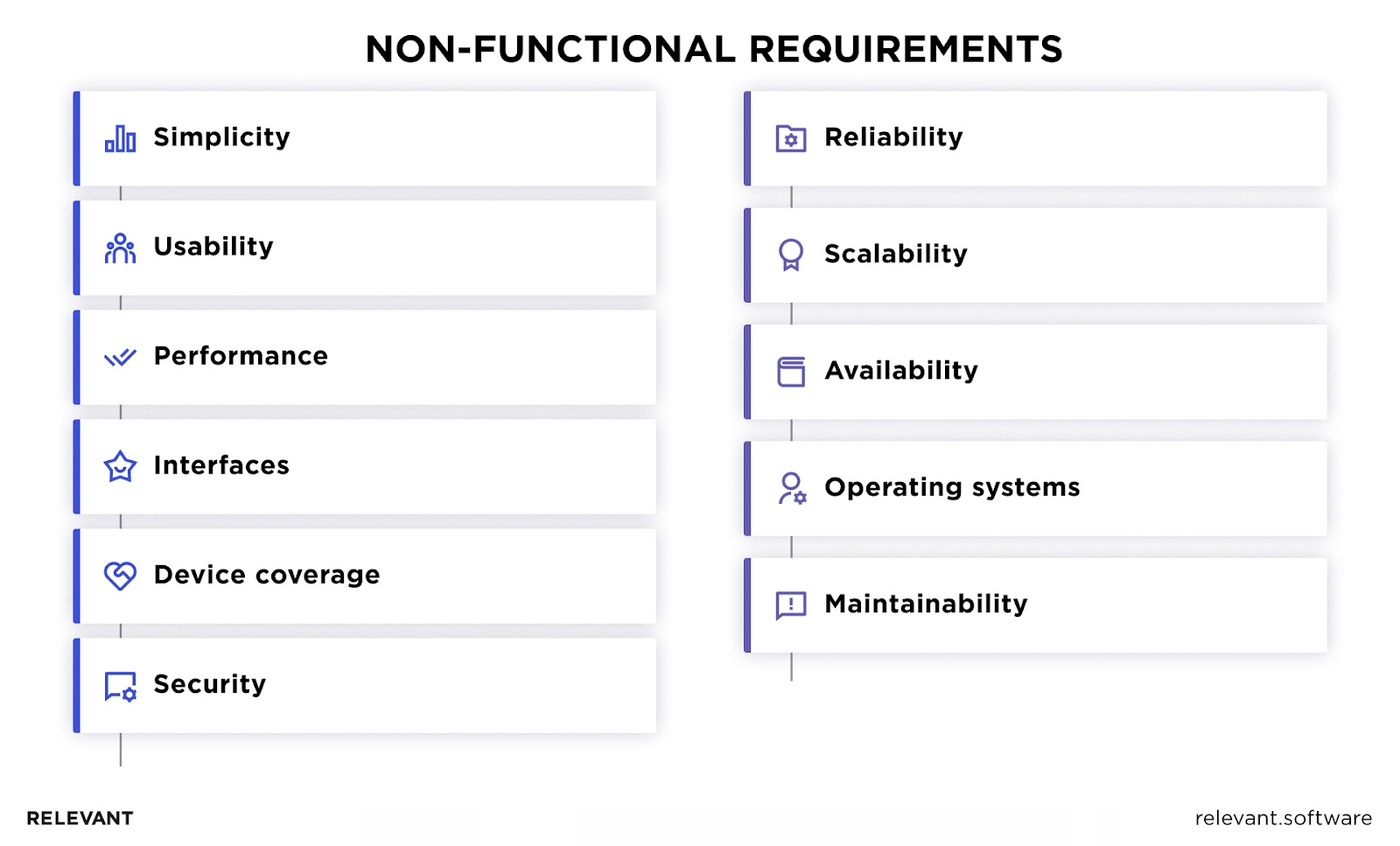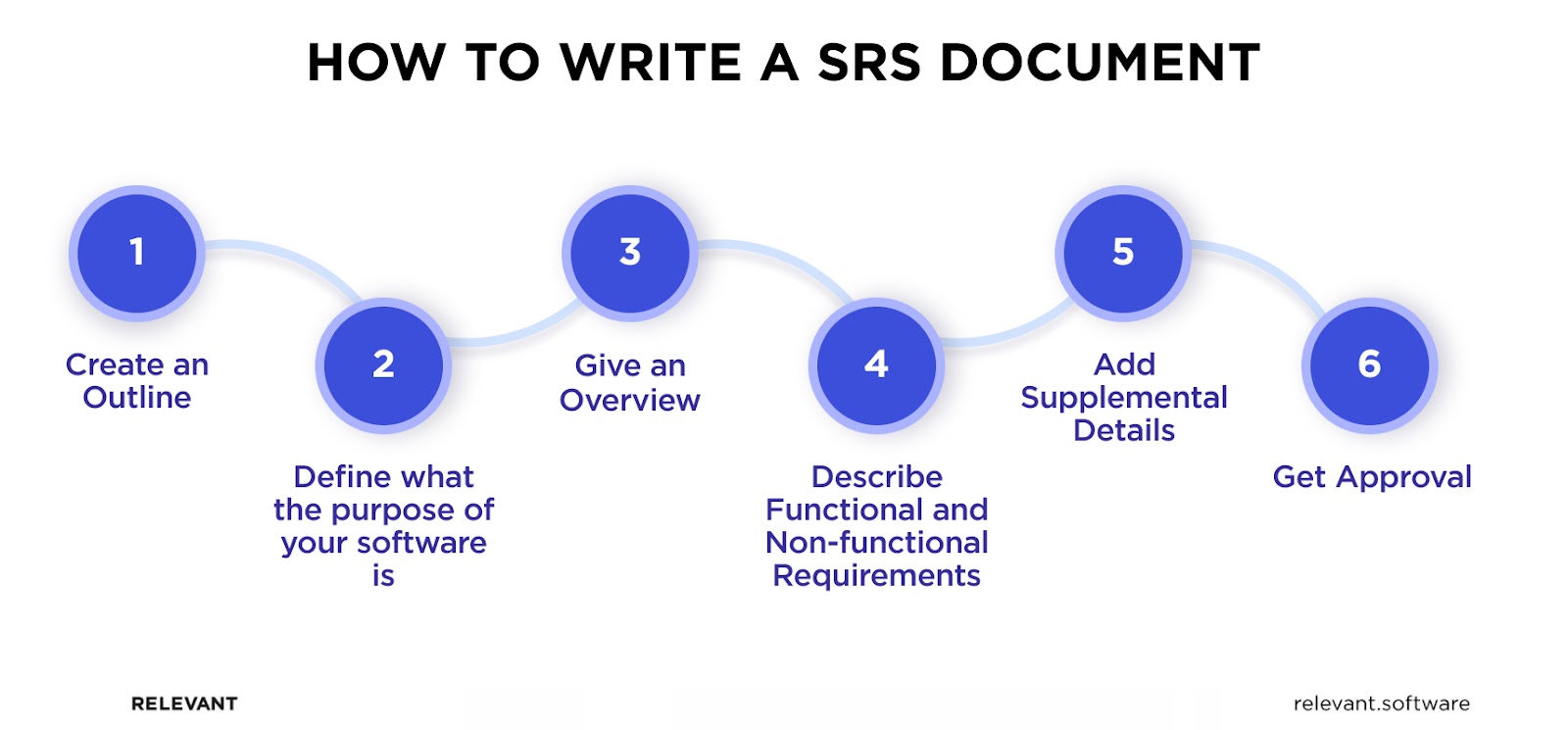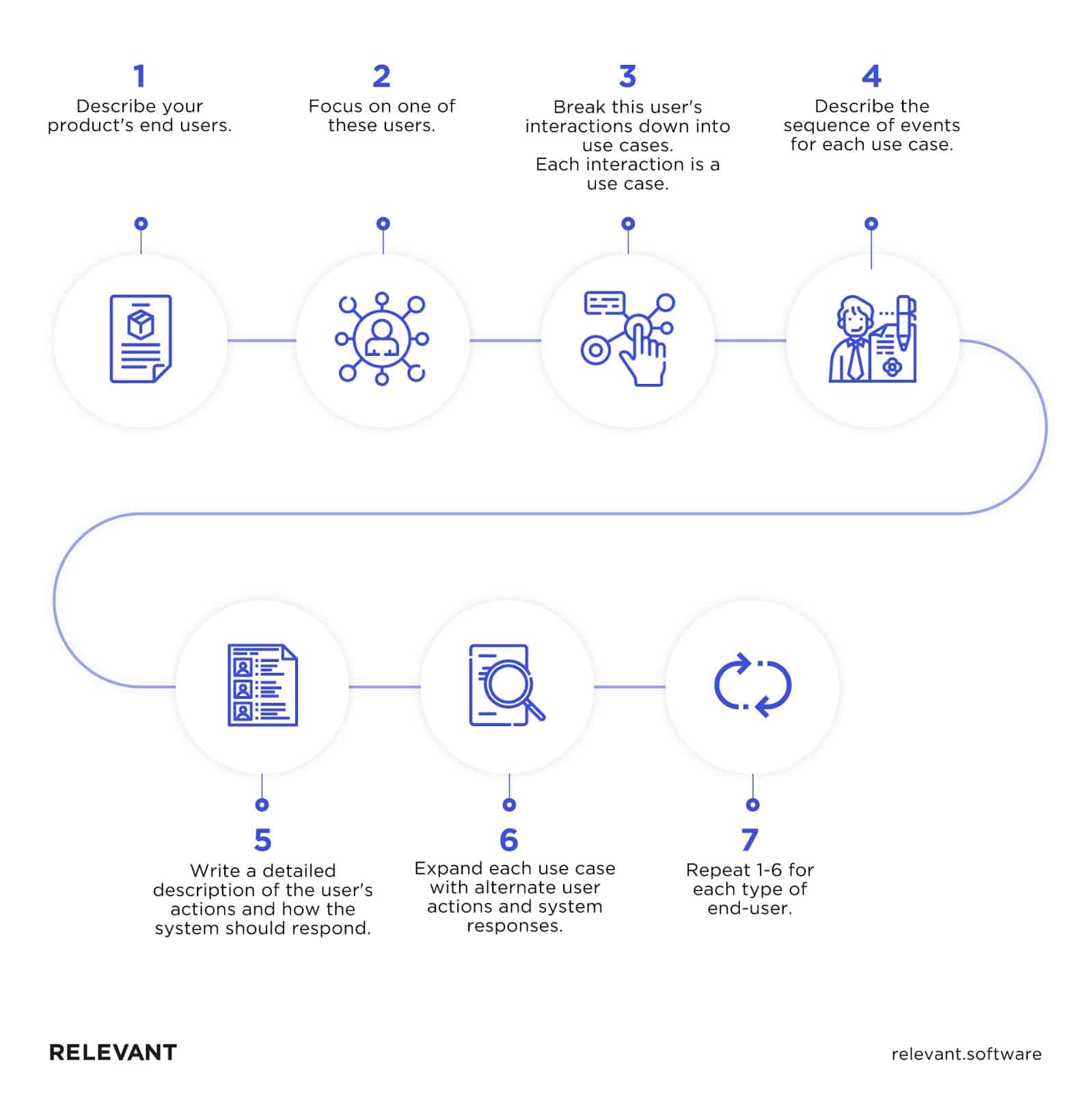Your 2025 Guide to Writing a Software Requirements Specification – SRS Document
Updated: June 4, 2025
Any application starts with an idea, and mobile app development begins with a Software Requirements Specification – SRS document. You might have a truly brilliant and unique digital product idea, but the journey to the implementation phase ultimately defines whether your application will succeed or fail. The SRS document is a vital part of this journey.
Approaching development without documentation and a clear plan leads to a chaotic implementation process, costly reworks, delays, or even a failed project. In fact, inadequate or incomplete requirements are the most common reason for project failure and a cause of nearly 50% of product defects. However, the good news is you can avoid all these issues and lay the groundwork for a successful outcome by creating accurate and understandable SRS documentation.

We provide companies with senior tech talent and product development expertise to build world-class software. Let's talk about how we can help you.
Contact usIn this guide, we explore the essentials of this document, why it’s a cornerstone for any software project in 2025, and what makes up an effective SRS in software engineering. Moreover, we’ll share an SRS document example and our expertise on how to write your own to make it a practical guide for stakeholders and all participants involved in the project development.
Table of Contents
What is SRS, and Why is This Document Important?
Let’s start with the SRS meaning. Software requirements specification is a technical document describing your project’s functionality, features, design, limitations, and goals. Simply put, an SRS outlines how an application should operate and how the product development team should build it. While you as a client may use it to define your project expectations and deliverables, your development company will use it to assess the amount of work, define the technology stack, and estimate the project cost.
The main goal of this report is to clarify all potentially vague aspects of development and communicate to the team:
- How the app should be built
- How it should work (preferably, it should include use cases)
- The app’s purpose, features, and behavior
Just as a statement of work (SOW), this document is crucial, especially when you outsource software development. An SRS document serves as a project roadmap for you and your dedicated team, leaving little room for confusion and misunderstandings. As a single source of truth that everyone can refer to, the requirement document sheds light on product specifications and deadlines, ensuring a shared understanding and alignment.
Moreover, it’s next to impossible to develop an app exactly what you expect without an SRS. Think we’re exaggerating? Now consider how software engineers will know which features to build, UX designers match the design to use cases, and QA specialists test the app. That’s why writing down clear software requirements guarantees your development team will build the product matching your needs. What’s more, an SRS is helpful for:
| Stakeholders | to understand what is going to happen with a project and which requirements must be met |
| Investors, if there are any | to evaluate the prospects of tool to make an informed decision |
| Software engineers | to define the programming languages and plan their work |
| Designers | to create mockups based on requirements and use cases |
| QA specialists | to evaluate the prospects of tools to make an informed decision |
What Does an SRS Include?
Software requirements specification is a blueprint for the development team, providing all the information they need to build the tool according to your requirements. But it also should outline your product’s purpose, describing what the application is supposed to do and how it should perform.
An SRS can vary in format and length depending on how complex the project is and the selected development methodology. However, there are essential elements every good SRS document must contain:
- Purpose of the digital product is a clear and concise statement that defines the intent of the solution. This statement should address your needs, outlining what the app will achieve once completed.
- Description of the product provides a high-level overview of the future tool, including intended users, the type of environment it will operate in, and any other relevant information that could impact the software development process.
- Functionality of the product describes the features, capabilities, and limitations or constraints that might affect the tool’s performance.
- Performance of the product should include requirements related to its performance in a production environment: speed, efficiency, reliability, and scalability.
- Non-functional requirements address such factors as security, compatibility, and maintainability.
- External interfaces include information about how the application will interact with other systems it must connect to. So, here communication protocols and data formats are described. Also, it outlines details of the screen layout, logic interface, hardware interface, and design.
- Design constraints or environmental limitations that may impact the development process or the software’s functionality.
- Assumptions and dependencies note the presuppositions made during the SRS document formulation and any external or third-party dependencies critical for project planning and risk assessment.
- Quality attributes define the standards for usability, reliability, and accessibility you expect in terms of the software’s quality.
- Security protocols explain the security requirements to protect the software against unauthorized access and ensure data privacy.
- Acceptance criteria specify the must-do list for the software to be considered finished and ready to go live, including all the tests the software needs to pass and the goals it must achieve.

The Difference Between Functional Requirements Document and Non-functional Requirements
To understand the difference, think of it this way: functional requirements are like the meat and potatoes of a meal, while non-functional are like the seasoning.
Functional requirements document is essential to the system’s core function, describing the features and fundamental behavior, just as meat and potatoes are the core elements of a meal. Without them, the system won’t work as intended, just as a meal won’t be satisfying without the main course. For example, when you register and sign in to a system, it sends you a welcome email.
On the other hand, non-functional requirements enhance the user experience and make the system more delightful to use, just as the seasoning makes a meal more enjoyable to eat. They specify the general characteristics impacting user experience.

Coming back to an example of the registration confirmation, a welcome email sent within five seconds after signing in would be a non-functional requirement.
So while functional requirements are crucial to the system’s operation, non-functional are equally important to the user’s needs and expectations. A system that is slow, unreliable, or difficult to use will significantly impact the user’s decision to use it.
| Functional requirements | Non-functional requirements |
| Outline the functions the app will have | Outline how the app will perform |
| Identify the app’s core features | Identify the way the app should behave |
| Explain what the app must do | Explain how the app should do it |
| Ensure the app meets user needs | Ensure the app meets user expectations |
How to Write a Software Requirement Specification Document
The creation of an SRS should be one of the first things to do when you plan to develop a new project. Writing it may seem daunting, but it’s essential to building successful software. Moreover, you can always use a software requirement specification example to simplify the task. The more elaborate and detailed your SRS is, the fewer chances for the development team to take the wrong turns.
To make the process of writing an SRS more efficient and manageable, we recommend you follow a structure that starts with a skeleton and general info on the project. Then it will be easier for you to flesh out the details to create a comprehensive draft. Here’s a six-step guide to creating an SRS document in 2025:

Step 1. Create an Outline
The first step is to create an outline that will act as a framework for the document and your guide through the writing process. You can either create your outline or use an SRS document template as a basis. Anyway, the outline should contain the following important elements:
- Introduction
- Purpose
- Intended use and target audience
- Product scope
- Definitions
- General description
- Business requirements
- User needs
- Product limitations and constraints
- Assumptions and dependencies
- Features and requirements
- Features
- Functional
- External interface
- Non-functional
- Supporting information
Step 2. Define What the Purpose of Your Software is
In fact, this section is a summary of the SRS document. It allows you to write a clear picture of what you want your product to do and how you want it to function. So, here you should include a detailed description of the intended users, how they will interact with the product, and the value your product will deliver. Answering the following question will help you to write the purpose:
- What problems does your product solve?
- Who are the intended users?
- Why is your product important?
Building on the basic summary of SRS, it’s a good idea to also think about how your product fits into the bigger picture. Look at what makes your product stand out from the rest and how it might change the game in its market. It will help you sharpen its purpose and value proposition.
Step 3. Give an Overview
Here’s the section where you clarify your idea and explain why it can be appealing to users. Describe all features and functions and define how they will fit the user’s needs. Also, mention whether the product is new or a replacement for the old one, is it a stand-alone app or an add-on to an existing system? Additionally, you can highlight any assumptions about the product’s functionality. And don’t forget to mention what makes your product special or different from others, and make sure to share these unique points clearly.
Step 4. Describe Functional and Non-functional Requirements
Often, clients don’t have a clear idea about the intended functionality at the start of the project. In this case, Relevant cooperates closely with you to understand the demands and assigns business analysts to assist with it.
Whether you write it internally or with the help of external experts, you should detail all the requirements associated with your app. For your dedicated development team to understand it properly, describe this information adequately. It would help them if you include use cases here as well since they can vividly illustrate how a user will interact with your system.
Did you know that performing a technical feasibility study as part of the requirement-gathering phase can significantly enhance the project’s success rate? Relevant business analysts, along with our technical experts, assess your project against current technological trends, potential integration points, and existing solutions. In such a way, the software will be technologically viable and forward-looking.
Step 5. Add Supplemental Details
If you have something else to add, any alternative ideas or proposals, references, or any other additional information that could help developers finish the job, write them down in this section of the software requirements specification. You may have suggestions on technologies you want to use, ideas for design patterns, or examples of case studies that have tackled similar challenges. Here, you can also define priorities for certain features and highlight areas where your development team has room for flexibility and creativity. Get this: the more details you specify, the better the software will meet your expectations.
Step 6. Get Approval
Now it’s time to have stakeholders review the SRS report carefully and leave comments or additions if there are any. After edits, give them to read the document again, and if everything is correct from their perspective, they’ll approve it and accept it as a plan of action. Here, it’s important to include every change in the latest SRS version and inform your development team right away to ensure everyone is on the same page. After that, you’re ready to move toward app or web development.
How to Write Software Use Cases in an SRS
Use cases help you ensure that the users have a smooth and robust experience using your product. To write use cases, you should put yourself in the shoes of your intended audience and get a better understanding of how they will interact with your program. By doing so, you’ll be able to identify potential issues early on and ensure your product meets the users’ expectations and needs.
To begin, describe your product’s targeted users. Who are they, and what tasks will they need to perform with your software? Then, focus on one of these users and break down their interaction into use cases. Each use case will represent a specific interaction the user has with your solution.
Now depict the sequence of events that will take place for each use case. This will let you map out the user’s actions and how your software should respond. Then expand each use case with alternative actions and probable system responses to ensure that you’ve covered all possible scenarios.
Finally, repeat these steps for each user type. Thus, you’ll create a comprehensive set of software use cases that accurately represent how your application will be actually used. By following these steps, you’ll create software that truly delights your users.

What are the Characteristics of a Great SRS in Software Engineering?
We provide some features of a good quality SRS so you can ensure your technical requirements document is good enough to serve as a guide for your professional development team.
Explicit
An SRS requires clear and easy-to-read content using agreed terminology so that all members of the product development process can easily understand it. Very handy are visuals like diagrams, models, or schemes as they can explain some points straight away.
Measurable
Unless the software requirements are measurable, it will be hard to know whether you are going in the right direction and whether the team is completing the milestones. Project managers have to understand how to assess the project progress and validate and verify the end product against the specifications. So, make your requirements measurable.
Complete
The SRS document must contain all the features you want to build with enough detail for your development team to complete the project: software requirements, assumptions, dependencies, and prerequisites. The stakeholders should check whether every part of it is described or if any details are missing.
Viable
When writing the specifications, you should take into account the budget, timeframe, and tech realities of the current environment.
Flexible
Note that an SRS is a living document that may be updated and refined throughout the development process, so it’s important to keep it flexible and adjustable.
Verifiable
It’s also vital to make the document available to all development team members so they can refer to it whenever necessary. The indicator of clear requirements would be no questions for clarification or demands for more details from the team.
Consistent
The software requirements in the document shouldn’t contradict each other. Also, the format of the whole SRS should be consistent, and ensure you use the same terminology throughout the paper.
No Implementation Constraints
Although the software requirements specification requires detailed information, we don’t recommend you make it overly specific, impose technological or architectural solutions, or specify a design methodology, as it may restrict development.
Accurate
SRS documentation should accurately depict the product’s functionality, specifications, and instructions so that the team members have no additional questions while using it. So, make sure every requirement has only one possible interpretation by avoiding subjective suggestions, ambiguity, and loopholes.
By adhering to these characteristics, you can create an SRS document that meets the needs of all stakeholders and provides a comprehensive and clear plan of action for your development team.
A Software Requirements Specification Example
Below, we provide a condensed SRS document example for a mobile shopping app, “FashionStyle”.
Introduction
This document outlines the development plan for “FashionStyle”, a mobile app that will allow users to browse and purchase clothes from different brands. This plan is intended for software engineers, designers, and investors of the project.
Overall Description
In the age of e-commerce, users are constantly seeking convenient ways to shop. However, with so many brands and products available online, it can be overwhelming for customers to find what they want. “FashionStyle” aims to solve this problem by offering a platform where consumers can easily find and buy fashion items from a variety of brands.
Customers
The target customers are primarily fashion-conscious individuals who prefer to shop online. They are likely to be tech-savvy and comfortable using mobile apps to make purchases.
Functionality
- Users should be able to create an account with email or social media.
- Users should be able to browse and search for clothes based on brand, category, color, and price range.
- Users should be able to view product details, such as descriptions, images, and reviews.
- Users should be able to add products to a cart and checkout securely.
- Users should be able to receive push notifications about new arrivals, sales, and promotions.
Platform
The app will be built using React Native, a cross-platform framework that will allow for both IOS and Android app development. The app will connect to a REST API created with Node.js and MongoDB to store and retrieve information.
Development Responsibilities
The development team for “FashionStyle” will be responsible for programming the app, designing the user interface, and testing the app for quality assurance.
User Class and Characteristics
There will be two types of users for “FashionStyle”: customers and admins. Customers will be able to use all the app’s features, while admins will have access to additional features such as managing product listings and discounts.
System Features and Requirements
Functional
- Users should be able to browse and search for clothes based on brand, category, color, and price range.
- Users should be able to view product details, such as descriptions, images, and review
- Users should be able to add products to a cart and checkout securely
Internal Interfaces
User Interfaces
- Back-end software: Node.js
- Database software: MongoDB
- Front-end software: React Native
Hardware Interfaces
- IOS and Android mobile devices
Non-functional Requirements
Performance
- The app should load and be ready to use within 5 seconds.
- The app should react to user interaction within 2 seconds.
- The database should be optimized to ensure fast query performance.
Safety
- The app should ensure secure transactions and protect user data through encryption and other security measures.
Security
- The REST API’s keys should be stored securely.
Quality Attributes
Availability: The app should have a goal of 99.9% availability to ensure customers can shop anytime.
Correctness: The app should accurately display product information and ensure secure transactions.
Maintainability: The app should be continuously integrated so that features, updates, and bug fixes can be deployed rapidly without downtime.
Usability: The interface should be intuitive and easy to navigate, allowing users to shop and make purchases without confusion.
Common Mistakes to Avoid When Writing an SRS Document
Don’t let your software requirements specification become a confusing mess! While there is no right way to write the requirement document, we will highlight the most common mistakes to avoid to help you ensure that your requirements are crystal clear.
First, be careful not to be ambiguous in your language. Remember, a software requirements specification aims to prevent misunderstandings, so ensure your requirements can’t be misinterpreted. Provide a clear description for every functionality, and avoid using words with multiple meanings.
Second, avoid overcomplicating your document. Standardizing the language of your document is not that big of a deal. Simply avoid using jargon and define terms before using them. Also, it would help to use references, such as “as shown in” or “in accordance with”.
Third, don’t over-specify your requirements. The document is not intended to become a complete description of the system for developers and architects. Stick to the essentials and avoid providing too many extra details. This can make the document less readable and vaguer.
Finally, if you struggle with structure and formatting, use a software requirements specification example to achieve clarity. If you’re unsure how to handle parts of the software requirements specification template, contact Relevant. We’ll help you write a comprehensive specification document for your project and ensure your requirements are communicated effectively. Don’t let a poorly written specification document derail your project – take the time or assistance to get it right the first time.
Summary
The success of any software project relies heavily on the availability of a well-written Software Requirements Specification document. It’s a critical component that serves as a roadmap for developers and stakeholders, outlining what the software should do, its technical details, and user needs.
Although creating a comprehensive SRS takes time and effort initially, it will pay off later with a robust app that meets both your and your users’ expectations. Moreover, following our expert tips, you can create an effective and detailed specification document.
At Relevant, we recognize the importance of SRS in software engineering and have helped over 200 companies build successful products with the help of software requirements specification. We can draft your requirement document either as a part of a full-cycle project or as a part of a stand-alone discovery phase. We’ll help you get high-quality SRS and stay relevant with the best development practices.
Our core services:
Do you want a price estimate for your project?
Do you know that we helped 200+ companies build web/mobile apps and scale dev teams?
Let's talk about your engineering needs.
Write to us











